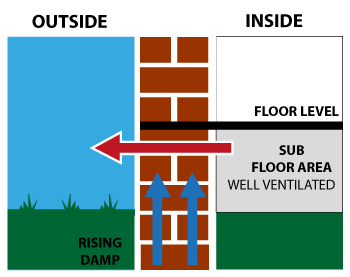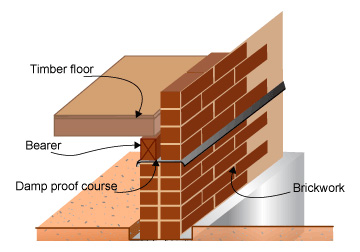Rising Damp And Other Problems Inadequate Subfloor Ventilation Can Cause
Rising Damp
What Is Rising Damp?
 Rising damp is dampness that moves up walls. Inadequate sub floor ventilation is a major cause of rising damp. This is because poor ventilation in the sub floor results allows humidity to build up. There is nowhere for the excess moisture to go so the damp rises up the walls. You can usually identify rising damp by a “tide mark” on the lower part of affected walls. Groundwater contains soluble salts which make this mark.
Rising damp is dampness that moves up walls. Inadequate sub floor ventilation is a major cause of rising damp. This is because poor ventilation in the sub floor results allows humidity to build up. There is nowhere for the excess moisture to go so the damp rises up the walls. You can usually identify rising damp by a “tide mark” on the lower part of affected walls. Groundwater contains soluble salts which make this mark.
Damp Course

The ‘damp course’ is a course of impermeable material laid in the foundation walls of buildings near the ground, to prevent dampness from rising into the building. It’s a waterproof membrane used as a protection against damp (see diagram below).
Brick walls in direct contact with the ground absorb moisture from the ground. This moisture rises up the wall until it reaches the damp course.
Tips To Alleviate Rising Damp
- Remove obstructions from your sub floor that block air flow. Make sure you check that soil isn’t blocking any vents.
- Second, if you already have traditional terracotta or cast iron vents consider replacing them. Modern metal vents have more holes and offer more ventilation than the older styles.
- Finally, install an efficient sub floor ventilation system appropriate to the size of the sub floor space.
Other Problems Caused By Rising Damp
Apart from inadequate sub floor ventilation, a build up of moisture (depending on the severity) causes problems like:

- Wood rot
- Problem odours
- Pest infestation (termites and other wood eating insects)
If left unresolved for a long period of time the build up of subfloor moisture will more often than not result in the growth of moulds, mildew and the release of airbourne fungal spores. This can cause serious health issues as well as causing structural issues in severe cases of wood rot. Houses with poor subfloor ventilation can also have quite a musty unpleasant smell.
The most viable and economical long term solution to the above is a subfloor ventilation system. View our DIY sub floor ventilation kits here.
The information provided is general in nature and is therefore not always in line with your unique situation and requirements. We advise you to seek professional advice as we cannot be responsible for the items you purchase for your project as each situation is different.


